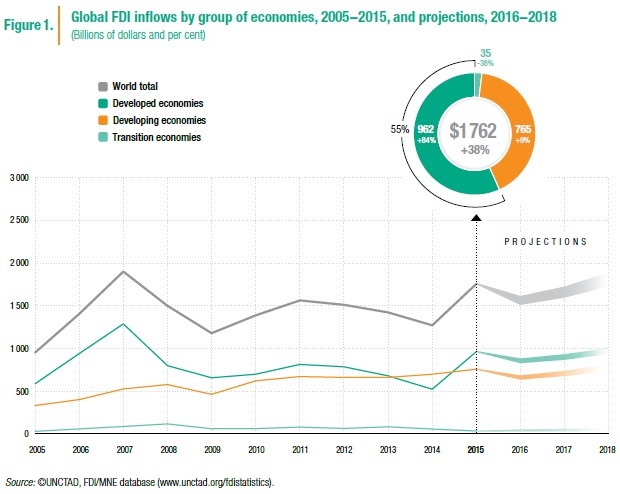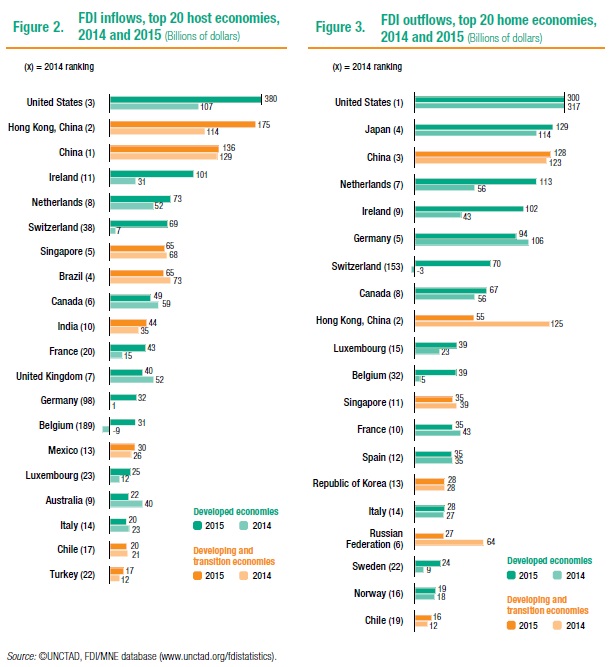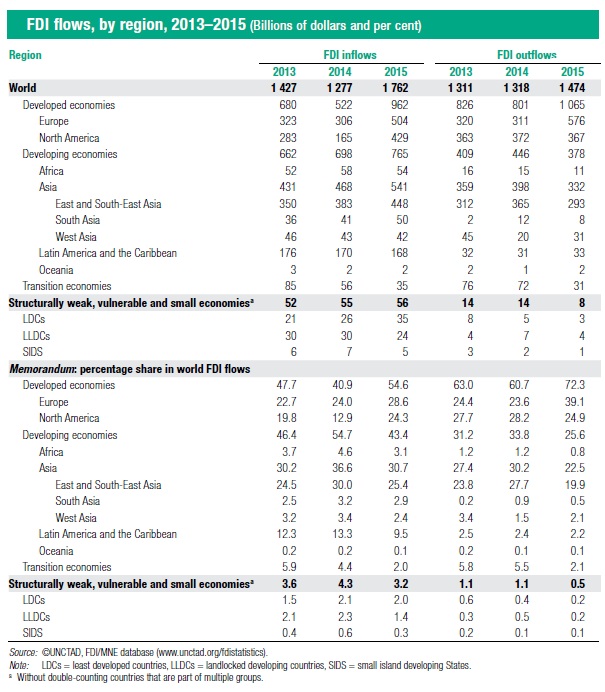News
Global foreign direct investment hit $1.76 trillion in 2015 – highest level since pre-crisis peak

Global foreign direct investment (FDI) flows soared in 2015, according to the latest World Investment Report 2016, subtitled Investor Nationality: Policy Challenges, but UNCTAD cautioned against over-optimism.
“A 38 per cent jump in flows, to $1.76 trillion dollars, gives hope that global FDI is at long last returning to a growth path. But we are not yet out of the woods,” UNCTAD Secretary-General Mukhisa Kituyi said.
Globally, that jump shows that the FDI recovery was strong in 2015. A surge in cross-border mergers and acquisitions to $721 billion, from $432 billion in 2014, was the principal factor behind the global rebound. Those acquisitions were due to large corporate reconfigurations by multinational enterprises, including shifting their headquarters, for strategic reasons and for tax inversion purposes.
FDI patterns were therefore affected by tax inversions, mainly in the United States of America and Europe. Several mega-deals resulted in the transfer of the tax domicile of multinational enterprises to jurisdictions that offer lower corporate tax rates and do not levy tax on global earnings. Discounting those large-scale corporate reconfigurations implies a more moderate increase of about 15 per cent in global FDI flows. The value of announced greenfield investment remained at a high level, at $766 billion.
Inward FDI flows to developed economies almost doubled to $962 billion. As a result, the share of developed economies in world FDI inflows leaped from 41 per cent in 2014 to 55 per cent in 2015 (figure 1), reversing a five-year trend during which developing and transition regions had become the main recipients of global FDI. Strong growth in inflows was reported in Europe, as well as in the United States where FDI almost quadrupled, albeit from a historically low level in 2014.

Developing economies also saw FDI inflows reach a new high of $765 billion, up 9 per cent on 2014, because of the performance of Asia. Developing Asia received record annual inflows, with FDI surpassing half a trillion dollars, and remained the largest FDI recipient region in the world. However, flows to both Africa and to Latin America and the Caribbean faltered while flows to the transition economies declined further. Developing economies continue to comprise half of the top 10 host economies for FDI flows (figure 2).
FDI outflows from developed economies increased by 33 per cent to $1.1 trillion, following three years of decline. As a result, developed countries were responsible for 72 per cent of global FDI outflows in 2015, up from 61 per cent in 2014. This 11 percentage point increase broke the nearly uninterrupted relative decline that began in 2007. The increase notwithstanding, developed country outward FDI remained 40 per cent short of its 2007 peak.
With outward flows of $576 billion, Europe became the world’s largest investing region. multinational enterprises from Japan were the world’s second largest investors (figure 3), while investments by multinational enterprises from North America stayed close to their 2014 levels, dipping slightly to $300 billion.

By contrast, FDI outflows declined in most developing and transition regions. A combination of challenges, including declining commodity prices and depreciating national currencies, and geopolitical risks were contributing factors. Against the general downward trend in FDI outflows from developing and transition economies, China was a notable exception: its outward FDI remained high, rising from $123 billion to $128 billion, as a result of which it held its position as the third largest investor in the world, after the United States and Japan.
A flurry of acquisitions raised the share of FDI in manufacturing to more than 50 per cent of cross-border mergers and acquisitions in 2015. Sales reached a historical high in absolute terms ($388 billion in 2015), surpassing the previous record set in 2007. FDI in the primary sector, on the other hand, was strongly affected by falling commodity prices, which resulted not only in reductions in planned capital expenditures but also in a sharp fall in reinvested earnings. Reduced FDI in extractives has had a particular impact on FDI flows to developing economies in Africa and Latin America and the Caribbean.
Investment flows to offshore financial hubs – including those to special purpose entities and offshore financial centres – declined in 2015 but remain high (those flows are excluded from UNCTAD FDI statistics). The magnitude of quarterly flows through special purpose entities, in terms of absolute value, rose sharply compared with 2014, reaching the levels last registered in 2012-2013. Meanwhile, investment flows to offshore financial centres continued to retreat from their recent high of $132 billion in 2013, but remained roughly in line with the flows of previous years.
The persistence of financial flows routed through offshore financial hubs, and the consequent fiscal losses due to the disconnect between income generation and productive investment, underscore the pressing need to create greater coherence among tax and investment policies at the global level.
FDI flows are expected to decline in 2016 in both developed and developing economies, barring another wave of cross-border mega-deals and corporate reconfigurations. UNCTAD forecasts that FDI flows are likely to contract by 10-15 per cent in 2016, reflecting the fragility of the global economy, the persistent weakness of aggregate demand, sluggish growth in some commodity-exporting countries, effective policy measures to curb tax inversion deals and a slump in multinational enterprises profits in 2015 to the lowest level since the global economic and financial crisis of 2008/09.
Elevated geopolitical risks and regional tensions could further amplify the expected downturn. Over the medium term, FDI flows are projected to resume growth in 2017 and to surpass $1.8 trillion in 2018.
Prospects for foreign direct investment remain muted in most regions
New data on global flows of foreign direct investment (FDI), published in the World Investment Report 2016, show regional variance but an overall picture of muted prospects. The report revealed for example that developing Asia remained the region receiving the largest amount of FDI while flows declined steeply to countries transitioning to a market economy in South-East Europe and the Commonwealth of Independent States.
Africa
FDI flows to Africa fell to $54 billion in 2015, a decrease of 7 per cent over the previous year. An upturn in investment into North Africa was more than offset by decreasing flows into sub-Saharan Africa, especially to West and Central Africa. In particular this was because low commodity prices depressed FDI inflows in economies based on natural resource.
Dynamic flows into Egypt boosted FDI to North Africa. FDI flows to Kenya reached a record level of $1.4 billion in 2015, resulting from renewed investor confidence in the country’s business climate and booming domestic consumer market. In Southern Africa, inflows to Angola reached $8.7 billion largely due to intracompany loans, while lacklustre economic performance pushed FDI in South Africa to $1.8 billion – the lowest level in 10 years.
In 2016, FDI inflows to Africa are expected to return to a growth path as a result of liberalization measures and planned privatizations of State-owned enterprises. This increase is already becoming apparent in announced greenfield projects in the first quarter of 2016.
Asia
Developing Asia, with FDI inflows reaching $541 billion – a 16 per cent increase – remained the largest FDI recipient region in the world. The growth was primarily driven by increased FDI in East and South Asian economies. In East Asia, FDI rose by 25 per cent to $322 billion, reflecting large equity investments related to a corporate restructuring in Hong Kong, China, and dynamic FDI flows to the services sector of China.
In South-East Asia, FDI to low-income economies such as Myanmar and Viet Nam soared, but this was offset by the lacklustre performance of higher-income countries, including Indonesia, Malaysia and Singapore. The FDI performance of India and Bangladesh pushed inflows to South Asia to $50 billion, an increase of 22 per cent from 2014. In West Asia, rising inflows to Turkey partly offset the negative impact of commodity prices and geopolitical tensions on FDI to oil-producing economies.
Hindered by the current global and regional economic slowdown, FDI inflows to developing Asia are expected to decline in 2016 by about 15 per cent, reverting to their 2014 level. Data on cross-border merger and acquisition sales and announced greenfield investment projects support the expected decline. However, flows to some Asian economies such as China, India, Myanmar and Viet Nam are likely to see a moderate increase in inflows in 2016.
Despite the decline in outflows from developing Asia by 17 per cent, to $332 billion, the region’s outward FDI in 2015 remained the third highest ever. Outward FDI from a number of Asian economies, including China and Thailand, increased. With outflows worth $128 billion, China remained the third largest investing country worldwide, after the United States of America and Japan.
Latin America and the Caribbean
FDI to Latin America and the Caribbean – excluding the Caribbean offshore financial centres – stayed flat in 2015 at $168 billion. There were contrasting performances in Central and South America, however. FDI flows to Central America rose by 14 per cent, to $42 billion, thanks to strong flows to Mexico and higher FDI in manufacturing across the subregion. FDI flows to South America, on the other hand, contracted by 6 per cent, to $121 billion, reflecting slowing domestic demand and worsening terms of trade caused by falling commodity prices. FDI flows to Brazil, the region’s principal recipient, fell 12 per cent to $65 billion. The decline in commodity prices also significantly affected flows to the Plurinational of State of Bolivia, Chile, Colombia and Peru.
FDI flows to the region may slow down further in 2016 as challenging macroeconomic conditions persist. In 2015, the value of announced greenfield projects dropped 17 per cent from their 2014 level, led by an 86 per cent decline in the extractive industry. Lower announced project values were also registered in the services sector. On the upside, national currency depreciation may motivate the acquisitions of assets. Cross-border mergers and acquisitions in the first quarter of 2016 were sharply up thanks to higher sales in Brazil, Chile and Colombia.
FDI outflows from the region rose by 5 per cent, to $33 billion in 2015. In Brazil, outward FDI expanded by a strong 38 per cent, an increase predominantly reflecting a significant reduction in reverse investment by Brazilian foreign affiliates. In Chile, outflows rose 31 per cent, to $16 billion.
Transition economies
FDI flows to countries transitioning from a planned to a market economy in South-East Europe and the Commonwealth of Independent States fell by 38 per cent, to $35 billion.
The FDI performance of transition economies differed by how they are grouped: in South-East Europe, FDI inflows increased by 6 per cent, to $4.8 billion, as better macroeconomic conditions and the European Union accession process continues to improve investors’ risk perception. In contrast, FDI flows to the Commonwealth of Independent States and Georgia declined by 42 per cent, to $30 billion, in a situation of low commodity prices, weakening domestic markets, regulatory changes and the direct and indirect impact of geopolitical tensions. Flows to the Russian Federation slumped to $9.8 billion as new FDI almost dried up due to the scaling back of operations and a string of divestment deals. The economic crisis and regulatory changes in the country have also reduced the scale and scope of round-tripping FDI.
After the significant decline recorded in 2015, FDI flows to transition economies are expected to increase modestly in 2016, excepting any further escalation of geopolitical tensions in the region. In the Commonwealth of Independent States, several countries, including Kazakhstan, the Russian Federation and Uzbekistan, have announced large privatization plans, which if realized will open new avenues for foreign investment.
Multinational enterprises from transition economies more than halved their FDI flows abroad. Geopolitical tensions, sharp currency depreciation and constraints in capital markets reduced outward FDI to $31 billion in 2015 – a value last recorded in 2005.
Developed countries
After three successive years of contraction, FDI inflows to developed countries bounced back sharply to the highest level since 2007. Exceptionally high cross-border merger and acquisition values among developed economies were the principal factor. Strategic considerations, but also tax optimization, drove acquisitions and corporate restructuring in sectors such as the pharmaceutical industry. Announced greenfield investment also remained high.
Inflows to Europe rose to $504 billion, accounting for 29 per cent of global inflows. This rebound was driven by large increases in Ireland, the Netherlands and Switzerland. Other major recipients were France and Germany, both of which recovered sharply from low points in 2014. Inflows into the United Kingdom of Great Britain and Northern Ireland fell to $40 billion but remained among the largest in Europe. In 2015, FDI inflows to North America reached $429 billion, surpassing the record high of 2000. In the United States, FDI almost quadrupled, albeit from a historically low level in 2014.
Barring another wave of cross-border merger and acquisition deals and corporate reconfigurations, the recovery of FDI activity recorded in 2015 is unlikely to be sustained at the same level in 2016. Recent regulatory measures meant to curb tax inversion deals are likely to discourage cross-border merger and acquisition deals and corporate reconfigurations. In addition, the economic growth momentum observed in some large developed economies weakened towards the end of 2015.
In 2015, multinational enterprises from developed economies invested $1.1 trillion abroad – a 33 per cent increase from the previous year. Europe became the world’s largest investing region owing to a strong rebound in their cross-border merger and acquisition purchases. Foreign investment by multinational enterprises from North America remained flat, with a significant increase in outflows from Canada being offset by a moderate decline of flows from the United States. Japanese multinational enterprises continued to seek growth opportunities abroad, investing more than $100 billion for the fifth consecutive year.
Least developed countries
FDI flows to structurally weak and vulnerable economies as a group increased moderately. Flows to the least developed countries (LDCs) jumped by one third to $35 billion; landlocked developing countries (LLDCs) and small island developing States (SIDS) saw a decrease in their FDI inflows of 18 per cent and 32 per cent, respectively.
FDI flows to LDCs rose by 33 per cent to a record high of $35 billion. In Asia, prospects of deeper economic integration in the Association of Southeast Asian Nations region spurred FDI in the Lao People’s Democratic Republic and Myanmar. FDI flows to Bangladesh hit a record high. Firms from China have become the largest holders of FDI stock in the LDCs, ahead of the United States. FDI to LDCs as a whole is expected to decrease in 2016, reflecting the continuing lull in FDI to a large number of African economies that rely heavily on natural resources.
Landlocked developing countries
FDI inflows to LLDCs fell for the fourth consecutive year to $24.5 billion – a drop of 18 per cent. Transition economy LLDCs accounted for the fall, particularly Kazakhstan, where flows halved. In spite of low commodity prices, Asian State-owned firms have been increasingly involved in Central Asia’s primary sector. Developing country investors, in particular from China, are holding an increasing share of FDI stock in LLDCs, as they do in LDC economies. FDI flows to LLDCs, in particular the transition economy subgroup, are expected to increase if large privatization plans materialize.
Small island developing States
FDI flows to SIDS dipped by 32 per cent to a five-year low of $4.8 billion. Reduced investment by energy firms contributed to a contraction in FDI flows to Trinidad and Tobago, the largest FDI host in the group. In Africa, FDI flows to Mauritius fell by 50 per cent, while in Asia and Oceania, the drop in FDI to Fiji and Maldives was less significant. Developing and transition economies now account for the majority of the top 10 investors in SIDS. FDI prospects in SIDS remain subdued, owing to the lack of large-scale investments in extractive industries and construction.

» Download: World Investment Report 2016: Investor Nationality – Policy Challenges (PDF, 4.93 MB)




